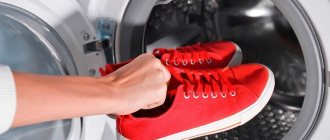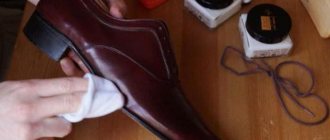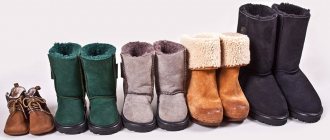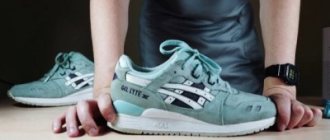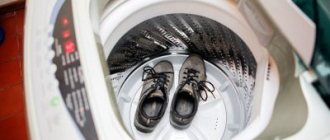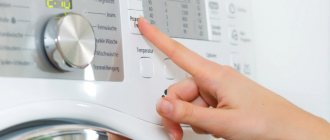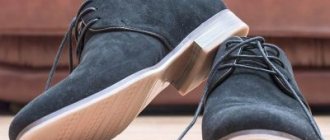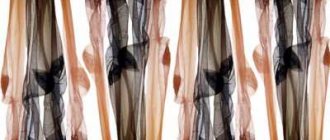Shoes often suffer from the vicissitudes of the weather. To restore it to its original appearance, a thorough cleaning is often required. The procedure directly depends on the material. Due to its fastidiousness, suede requires delicate care. Mistakes made during this process can lead to complete unsuitability of the product, so many housewives are interested in whether suede shoes can be washed.
Methods of cleansing
Artificial and natural suede is a material that is not recommended to get wet. Manufacturers answer negatively about whether suede boots can be washed in a washing machine. Due to prolonged exposure to a liquid environment, the material becomes soft.
As a result, further wear is no longer possible. Appearance also deteriorates greatly. You should only use a machine when cleaning suede as a last resort. At the same time, only those shoes that you don’t mind should be subjected to such a test.
Washing suede products at home
Natural suede is considered the most expensive. It is obtained from the skins of small livestock by tanning using fats and formaldehyde. The natural material is very durable and can withstand many washes.
Faux suede is a completely different matter. High-quality fabric (for example, Alcantara) is also not damaged by moisture and friction. Opinions differ on whether inexpensive suede can be washed. It is better not to wet some types of fabric at all, while others should be carefully washed by hand. The appropriate care regimen for your clothing is usually indicated on the label.
In the washing machine
When choosing a risky option, you need to be guided by the correct algorithm. The procedure is quite simple:
- Prepare a suede pair for processing. At this stage, the sole is cleaned, stains are removed, and the laces and insoles are removed.
- Place the shoes first in a special bag, and then in the drum of the machine. If you don’t have this device, you can use old towels.
- Pour in liquid powder. It is better not to use powdered products. They can provoke the appearance of divorces.
- Select a mode. In this case, “Delicate” or “Sneakers” are suitable. They provide for the minimum temperature, number of revolutions and time. You will have to abandon automatic drying and spinning.
Insoles and laces are washed separately.
After cleaning, you should put paper in your shoes. Dry the product in the fresh air or in a ventilated area. The product should be located away from radiators, boilers and other parts of the heating system. To understand whether it is possible to wash shoes made of suede fabric in an automatic washing machine, you need to determine the degree of its delicacy. For example, UGG boots and dress shoes are strictly prohibited from being subjected to such treatment.
Sneakers and house shoes made from artificial suede can be machine washed. In this case, you should use detergents for delicate fabrics. They do not contain whitening ingredients. After the shoes are completely dry, they need to be treated with a rubber brush. In this way, the suede is restored to its velvety quality and the pile is raised.
Drying rules
Regardless of the type of suede, whether it is natural or artificial, the material cannot be dried on a radiator, in direct sunlight or with a hair dryer. Any heat source can cause it to harden and crack.
In order to maintain the original shape of the product after getting wet, suede shoes must be stuffed with crumpled paper or special inserts used during drying. If your shoes are light-colored, you should never use newspaper for these purposes—color stains from soaked printing ink may appear on the surface of the porous leather. As moisture is absorbed, the paper must be replaced several times.
Hand washing suede shoes
The product must not be cleaned until it is dry. This will lead to stains that are unlikely to be washed off. Cleaning can be done using the dry method. Dirt and dust are removed with a stiff brush. The remaining worn areas are wiped with a regular eraser. If this procedure does not bring the desired effect, suede shoes are washed.
To do this you will need a soap solution. It should be warm. To enhance the positive effect, ammonia should be added to the finished mixture. The product is treated with a napkin soaked in the resulting composition. In this case, the shoes should not get wet through. Afterwards, the suede surface is wiped with a cloth soaked in clean water. The last step is drying.
We recommend:
How to wash suede
How to get rid of stains?
Faded marks formed due to point contact with an aggressive substance and stains that cannot be removed are dealt with using aerosol dyes. Due to the high toxicity of coloring substances, the procedure should be carried out on an unglazed balcony or in the open air.
Otherwise, the pungent chemical smell will cause headaches. To clean white suede, dissolve a spoonful of baking soda in a glass of low-fat milk (the reading should be below 1.5%), soak a rag (or gauze swab) in the mixture and wipe the top material, paying special attention to problem areas. Then take an undyed cotton cloth, slightly wet it and wipe the boots. Another way: use clear vinegar (may cause shedding, test on a small area first)
A toothbrush is dipped into the essence and then brushed over the stains. At the end of the procedure, be sure to give the pile a direction.
You can also remove stains from light-colored materials using lemon. Use its zest to spot-treat the stain.
If the problem is whitish salt stains, then resort to the following cleaning methods:
- The shoes are kept over a boiling pan for 5–8 minutes. Dirt is removed with a rubber brush.
- The potatoes are peeled, divided in half and the cut area is rubbed first on the spots and then on the entire surface. Afterwards, wipe with a cleansing cloth and treat the lint with a brush.
- Old contaminants of an organic and inorganic nature are removed using ammonia (a caustic substance, therefore it requires testing in an inconspicuous area of the sneakers) and semolina. The first softens the crust of the stain, and the cereal absorbs the fat. After the semolina has done its job, it will need to be cleaned off.
- If during a preliminary test it turns out that the material is shedding due to ammonia, it is worth diluting the liquid with water. This rule also applies to vinegar.
Ways to deal with other types of stains:
- Freezing the chewing gum will help (apply ice);
- apply corn flour, talc or potato starch to the greasy stains (allow the liquid to be absorbed, then brush);
- brown suede is rubbed with coffee using a sponge;
- to remove organic contaminants, rub half of the box with sulfur (then treat with a damp rag);
- black and colored lines are removed using an eraser.
What products can be used for washing?
It is allowed to use special foam to clean shoes. It is sprayed onto all problem areas and spread with flannel. In the absence of synthetic detergents, it is allowed to use:
- petrol;
- coffee grounds;
- talc;
- baby powder;
- nail polish remover.
Talc
If suede shoes have a light shade, use a milk-soda solution instead of soap. To prepare it, you will need baking soda and skim milk. Greasey stains can be removed using dry cornstarch. It should remain on the suede surface for 3 hours. After this period ends, the product is treated with a hard bristle brush. Along with your shoes, you can purchase special cleaning equipment and protective aerosol.
Cleaning boots from the inside
The smell inside disappears if you remember to dry your boots after each wear, always removing the insoles to carry out the same procedure, but separately from the main products. This is especially true for winter shoes with thick pile made of natural material inside.
An additional measure to eliminate the unpleasant odor from boots is the systematic and moderate spraying of the insulating lining with a pharmaceutical disinfectant or a homemade solution. For the latter, a mixture of alcohol and ordinary water in a ratio of 8 to 1, respectively, is suitable.
To prevent caking of the insulating layer and the subsequent accumulation of excess moisture and dirt in this area, the lining is periodically “boosted” by running across the surface with a brush or simply with your fingers.
Additional ways to keep the inside of your boots smelling nice:
- Systematically pour baking soda inside and leave it overnight. Residues can be easily removed with a vacuum cleaner or regular shaking, holding the boots with the tops down. The powder absorbs unpleasant odors and saturates the fibers of the pile with a composition unfavorable for pathogenic bacteria.
- After drying the boots, treat them with a specialized product. Unlike conventional aerosol deodorants, used by many people for the same purpose, sprays not only scent shoes, but also prevent the bacteria responsible for the unpleasant odor from multiplying.
- Leave already used but dry tea bags with tea leaves in the middle in items standing to dry.
What not to do to avoid damaging suede shoes when washing
To prevent contamination, suede products are not recommended to be worn in bad weather. Walking through puddles and snowdrifts negatively affects the general condition of the shoes. Before leaving the house, the suede surface should be treated with a protective aerosol. If stains still appear, you should refuse:
- use of ordinary cleaning products and devices;
- drying near electrical appliances;
- automatic cleaning of products with compromised integrity.
Following the recommendations on how to wash suede sneakers and boots will increase their service life. Thanks to gentle processing, you can quickly and effectively eliminate scuffs and return damaged shoes to their former shine.
5/5 — (1 vote)
Removing old stains
Sometimes, when you take suede boots out of the box that have been in the closet for several months, you may find a stain on them. Old stains are more difficult to clean off, so you will have to resort to a special method. The algorithm of actions is as follows:
- boil a full pan of water;
- hold the boot over the steam until the suede softens;
- walk over the surface with a brush dipped in water;
- dry your suede shoes.
After drying, it is imperative to impregnate the shoes, that is, treat them with a special protective agent. Deep impregnation will restore suede, increase its water resistance and wear resistance.
Removing contaminants
Before washing, you need to examine the jacket for various contaminants. Most, even the most difficult stains at first glance, can be removed not only with the help of expensive specialized products, but also by using available materials.
Small greasy areas can be revived with vinegar, one tablespoon of which must be dissolved in a liter of water.
You can get rid of a greasy stain with ordinary table salt, which you need to apply in a thick layer to the stain, and then brush off the excess that has absorbed the dirt.
To remove most known stains on dark suede jackets, coffee grounds can be used, which will not only remove the dirt, but can also refresh the appearance of the item.
Potato starch, which can be used for light suede too, is a great remedy for abrasions. Talc may be used as an alternative.
ON A NOTE:
To tidy up a white suede jacket, you need to use a separate cleaning kit, in particular a separate brush, otherwise there is a high probability of forgetting to treat the common part and ruining the light-colored material.
